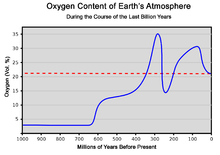Talk:Silurian
| Geology: Periods B‑class Top‑importance | |||||||||||||
| |||||||||||||
| Palaeontology B‑class High‑importance | ||||||||||
| ||||||||||
| Software: Computing Unassessed | |||||||||||||
| |||||||||||||
Since this article is about Silurian time, I changed the subdivision descriptions to reflect this - epoch rather than series (which refers to the rocks) and early/late rather than lower/upper for the same reason. This is also more consistent with other geological time period articles.--Geologyguy 16:56, 27 May 2006 (UTC)
AMK152's Geotimeboxes
AMK152 proposed in edits of 27 December 2006 a geotimebox for this article as follows:
I feel that the box information that is appropriate for the article is already in the footer, and that other extraenous information, such as previous eras, can be supplied where important, by links from the text. I removed the geotimebox and left the footer, pending discussion. --Bejnar 21:13, 27 December 2006 (UTC)
"Pridoli epoch" vs. "Přídolí epoch"
I don't doubt that Přídolí is the proper spelling in Czech of the place after which the Pridoli epoch is named. But can anyone provide a substantial reference for calling the "Pridoli epoch" the "Přídolí epoch" in English? There is plenty of evidence for "Pridoli epoch" in English, see, e.g. The Pridoli, GeoWhen Database, etc. --Bejnar (talk) 13:14, 20 November 2007 (UTC)
- We (Wikipedia) have had pretty good consensus to use the ICS nomenclature... but they are pretty inconsistent in this case! Under the title "GSSP for the Ludlow – Pridolí Boundary" (accent on final i), they refer to the "Pridoli Series" (no marks at all) but use diacritics on the location names such as Požáry Section, then in what appears to be the primary reference for the stage, cite "Přídoli Series" (marks on r and initial i but not final i). I'd say we're on our own on this one, whatever our consensus decides. Personally, I tend to appreciate proper non-English accents and so on in proper names used in English, though I would not get very upset if they were not used. Cheers Geologyguy (talk) 15:20, 20 November 2007 (UTC)
- The USGS appears, and it may only be an appearance, to use Pridoli, without diacritics. "Divisions of Geologic Time—Major Chronostratigraphic and Geochronologic Units" USGS and "Strategraphis Nomenclature and Description" Suggestions to Authors of the Reports of the United States Geological Survey But those usages are in tables. --Bejnar (talk) 20:03, 20 November 2007 (UTC)
Links to Groups
Though they are intended to be, I'm not at all sure that the links within the 'subdivisions' section to the Ludlow, Wenlock and Llandovery groups are helpful to the reader as these are simply former divisions made by British geologists and do not correspond directly with the epochs which this section primarily deals with. The linked pages comprise material from Encyclopaedia Britannica 1911 edition, much of the content of which has been superceded in any case. Overall the unsuspecting, non-expert reader is more likely to be misled. cheers Geopersona (talk) 05:28, 29 April 2013 (UTC)
Link to English version of graph 1?
Since the source image and corresponding text for Ref. 1 is in German, it's inclusion in the English version of Wikipedia is a hindrance to understanding. Someone modified and translated a version into English (see thumbnail), which I propose should replace the link, but I can't seem to figure out to change the figure. Animalparty (talk) 19:57, 26 October 2013 (UTC)

Terrestrial fungi
This is a group that has been overlooked in the article. For example, Prototaxites, which was probably a fungus or lichen, would have been the tallest organism of the late Silurian. In addition, since fossilized hyphae and spores of other terrestrial fungi recovered from Wisconsin date as early as Ordovician (460 Ma), and have probably colonized land considerably earlier than plants, the statement "Life also began to appear on land..." in the introduction to the article, is incorrect. Belsavis (talk) 12:12, 3 November 2013 (UTC)
- B-Class Geology articles
- Top-importance Geology articles
- Top-importance B-Class Geology articles
- B-Class Geological periods articles
- Top-importance Geological periods articles
- Geological periods articles
- WikiProject Geology articles
- B-Class Palaeontology articles
- High-importance Palaeontology articles
- High-importance B-Class Palaeontology articles
- WikiProject Palaeontology articles
- Unassessed software articles
- Unknown-importance software articles
- Unassessed software articles of Unknown-importance
- Unassessed Computing articles
- Unknown-importance Computing articles
- All Computing articles
- All Software articles




